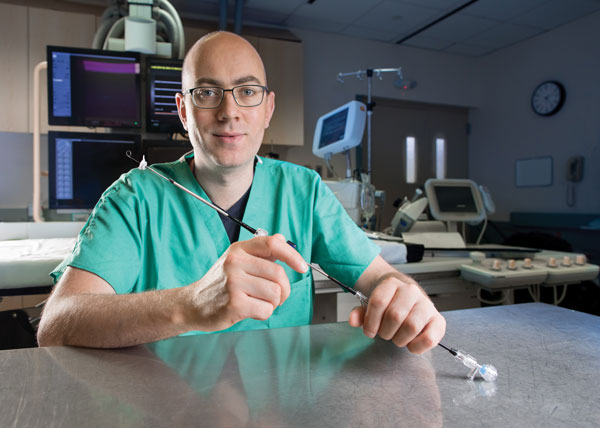
Toby Rogers, MD, PhD
The development of percutaneous treatment options for structural heart defects is one of the most fertile areas of innovation in cardiovascular care—with transcaval TAVR leading the pack. It offers a new treatment option to patients in need of aortic valve replacement who are too sick for open-heart surgery and whose iliofemoral artery anatomy prevents the use of more traditional percutaneous routes to the heart. It is also a less risky and less painful approach than either transapical or transaortic access to the aorta.
As in many such endeavors, work-arounds are often good enough until something better comes along. The “good enough” in transcaval TAVR has been the off-label use of nitinol cardiac occluders. Now MedStar Heart & Vascular Institute’s Toby Rogers, MD, PhD, is testing a newly designed, first-ever dedicated occluder device aimed at improving outcomes and reducing complications.
Plugging Critical Holes
The occluder plays a critical role in the transcaval technique. During transcaval valve replacement, an electrified guidewire is used to cross from the inferior vena cava to the abdominal aorta to create a connection between the two vessels. This allows the catheters to bypass the iliofemoral arteries that are diseased.
During the procedure the connection is widened so that a catheter can be advanced from the vein through to the aorta to allow TAVR to be performed. The fistula from the aorta to the inferior vena cava is closed with the occlude device. While the occluder device is being deployed, higher pressure in the surrounding tissue ensures that bleeding from the aorta spontaneously decompresses back into the vena cava.
A Better Occluder Device
“We are currently using an occluder device originally designed to plug holes in babies’ hearts,” explains Dr. Rogers. “While it gets the job done, it is not designed for transcaval closure. The new device has been designed to be easier to deploy and promote rapid hemostasis.”
The new device is shaped like a double umbrella. “When positioned inside the aorta, the umbrella opens on both sides of the wall of the aorta, and the catheter is withdrawn through the vein,” he says.
The FDA early feasibility study has enrolled 12 patients at MedStar Washington Hospital Center; Emory Hospital, Atlanta; and Henry Ford Hospital, Detroit. “The early results are promising, and we will have the full results from the study later this year,” Dr. Rogers adds.
Last year more than 100,000 TAVR procedures were performed in the United States and approximately 5 to 10 percent of these required non-transfemoral access. “As a high-volume TAVR center, MHVI is well positioned to test new innovations in this very quickly evolving field,”Dr. Rogers says.
If you have any additional questions or wish to discuss a patient case, please contact Dr. Rogers directly at 202-877-5975, or Toby.Rogers@MedStar.net.









